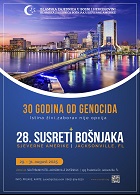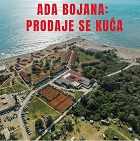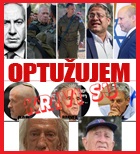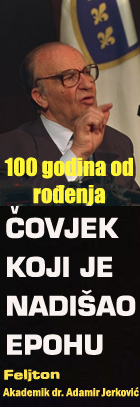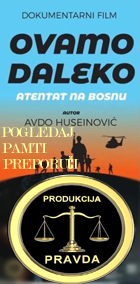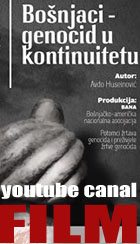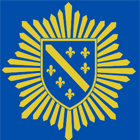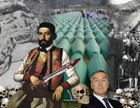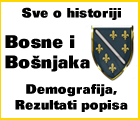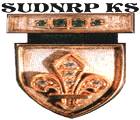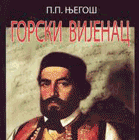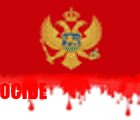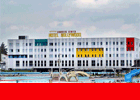
Historija
Harvard University, USA,1993.
A BRIEF HISTORY OF BOSNIA-HERZEGOVINA
 BY ANDRAS RIEDLMAYER, Harvard University
BY ANDRAS RIEDLMAYER, Harvard University19,741 sq. mi. / 51,130 sq. km (about the size of West Virginia; 1/4 larger than Switzerland). Picturesque mountain scenery (Bosnia\'s capital Sarajevo hosted the 1984 Winter Olympics), much of it covered by forests; some coal and minerals, no oil. Bosnia\'s traditional borders, established in the medieval period, are: the Sava River (in the N), the Drina River (E/SE), and the Dinaric Alps (in the W). Herzegovina (\"the Duchy\") is the historical name for the country\'s southwestern region (around the town of Mostar). Located in the heart of Europe (as the crow flies, Sarajevo is closer to Rome than Milan is).
Population
In 1991 Bosnia was home to 4,365,000 people (twice as many as live in West Virginia; 1/3 fewer than Switzerland); its largest city was Sarajevo (pop. 526,000). Much of Bosnia\'s population is urban and (until April 1992) was employed in manufacturing, mining, technology and service industries. It is (or was) a modern, industrialized European country with respectable educational and health-care statistics. Almost all (over 95%) of the people speak the same language (called Bosnian or Serbo-Croatian), and come of the same European racial stock, descended from Slavic tribes that settled in the area in the early Middle Ages.
The people of Bosnia are traditionally called Bosnians. For reasons having to do with recent history (and as much with 20th-century ideologies as with traditional religious allegiances), Bosnians whose ancestors were of the Catholic faith are now identified as Bosnian Croats (17%), while those of Eastern Orthodox background are now identified as Bosnian Serbs (31%). The largest group of the Bosnian population, however, are the Muslim Slavs (44% in the 1991 census), descendants of Christian Bosnians who accepted Islam some 500 years ago.
Until the late 19th century, people of all three faiths identified themselves simply as Bosnians. Most Bosnians today are in fact highly secularized, and about a third of all urban marriages in Bosnia in recent decades have been between partners from different religious/ethnic backgrounds.
While there were some villages in the countryside where one group or the other predominated, Bosnia\'s towns and cities have traditionally been the shared home of people from all ethnic and religious groups. The latter include Jews, who found a haven in the tolerant city of Sarajevo in 1492, following their expulsion from Spain. Unlike Jews in Venice and elsewhere in Europe, Sarajevo\'s Jews were not confined to a ghetto. The city\'s principal mosques, its synagogues and Christian churches are all located in close proximity to each other, a visible sign of the intermingled public and private lives of its ethnic and religious communities.
Medieval Bosnia (ca. 1200-1463)
Like the rest of the Mediterranean region, Bosnia was part of the Roman Empire during the first centuries of the Christian era. After the fall of Rome, the area of Bosnia was contested between Byzantium and Rome\'s successors in the West. By the 7th century AD, Bosnia was settled by Slavs, who formed a number of counties and duchies. The 9th century saw the establishment of two neighboring kingdoms: Serbia (southeast of Bosnia), and Croatia (in the west). In the 11th-12th centuries, Bosnia was governed by local nobles under the authority of the Kings of Hungary (the large kingdom to the north, which had also taken over neighboring Croatia).
Around 1200 A.D., Bosnia fought for and gained its independence. To retain it, the Bosnians had to fend off not only the Hungarians, but also their powerful neighbor to the east, the Kingdom of Serbia. The independent medieval Kingdom of Bosnia endured for more than 260 years (somewhat longer than the United States has thus far). Its population was entirely Christian, but in a tolerant environment unusual for the Middle Ages there was not one Christian church but three. While most Bosnians were Roman Catholics, Eastern Orthodoxy and a schismatic local Bosnian Church also had adherents. All three churches were organizationally weak, their clergy largely uneducated, and none could count on steady and exclusive state patronage (these factors later contributed to the decision by a large part of the Bosnian people to abandon Christianity for Islam).
In the 14th century, the Ottoman Turks (an Islamic state originating in Asia Minor) embarked upon their conquest of the Balkans. By 1389 Serbia had suffered a humiliating defeat at the hands of the Turks (at the famous battle of Kosovo) and had been reduced to the status of an Ottoman vassal. Through skillful maneuvering between its more powerful neighbors, Bosnia managed to retain its independence until 1463, when it also succumbed to the Turks.
Bosnia\'s Ottoman Centuries (1463-1878)
The conquering Ottoman armies marched on towards Vienna, and in the century that followed, many Bosnians (for both spiritual and social reasons) dropped their allegiance to the weak and disorganized Christian churches and adopted the triumphant faith of the Islamic conquerors. The spread of Islam was aided by itinerant Muslim popular preachers, who taught a fairly broad-minded and inclusive form of Islam that allowed Bosnians to adapt their old traditions to the new faith. The Ottoman sultans and their local governors embellished Bosnia\'s towns and cities with splendid mosques and established pious endowments that supported schools, Islamic seminaries, libraries, orphanages, soup-kitchens and almshouses. Many Muslim Bosnians rose to join the ranks of the Ottoman ruling elite as soldiers, statesmen, Islamic jurists and scholars; not a few attained the highest posts in the Empire. Within Bosnia, a distinctive Bosnian Muslim culture took form, with its own architecture, literature, social customs and folklore. For more than 400 years Bosnia retained a distinct identity as the Eyalet of Bosna, a key province of the Islamic Ottoman Empire. A native aristocracy of Bosnian Muslim notables ruled the province in all but name, ready to defend their autonomy by force of arms, if need be, against any efforts to curtail it. Thus Bosnia shared both in the Empire\'s days of prosperity and glory and in the decline that ensued in the 18th century. As the Ottoman Empire\'s borders began to recede, Muslim Slavs who had been driven out of the lost provinces found a refuge in Bosnia, reinforcing the already large Muslim element within its multi-ethnic population.
Bosnia\'s Ottoman centuries came to an abrupt end in 1878, when the Great Powers of Europe met in Berlin to decide what to do about the Ottoman Empire. Eyed hungrily by these same powers (as an object of colonial conquest), the Ottoman Empire by this time seemed ripe for the fall. Unable to pay its financial obligations, it was threatened both by internal civil disorder and by the aggressive designs of its neighbors. What saved the Ottoman Empire from disintegration for another forty years (until the end of World War I) was the inability of the Great Powers to agree on a division of the spoils. A compromise was reached at Berlin, according to which Ottoman finances were entrusted to an international commission composed of the creditors, while the Empire\'s borders were, for the moment, to be left largely intact. There were to be some exceptions: Bosnia-Herzegovina was to be administered by Austria-Hungary (which had felt left out in the race for colonies); the island of Cyprus was assigned to Britain (which insisted it needed it to protect the Suez Canal); and, after 500 years of Ottoman rule, Serbia, Montenegro, and Bulgaria were given full independence (at Russia\'s insistence).
Bosnia Enters the 20th Century (1878-1918)
The newly installed Austro-Hungarian administration in Bosnia was determined to turn it into a showcase \"model colony.\" Railroads and industries were developed with state subsidies; new schools, public buildings, parks and other icons of modernity were to symbolize the benefits of the new regime. There was a building-boom in Sarajevo and little intellectual circles began to discuss up-to-date European ideologies in the coffeehouses. Among these new ideologies, alas, was nationalism, that bastard offspring of 19th-century Romanticism and social Darwinism.
The nationalist dream of a great South Slav state united under the leadership of Orthodox Serbia was eagerly promoted from across the border (by Serbian agents covertly financed by imperial Russia, the self-appointed \"guardian of all Eastern Orthodox peoples\"). The Muslim Slavs saw no place for themselves in this proposed new order and continued to advocate the old Bosnian ideal of a pluralist, multi-confessional society; for obvious reasons the latter was also the orientation favored by the Austro-Hungarian authorities. Some Bosnian Muslims emigrated to Turkey and other parts of the Ottoman Empire, fleeing Austrian military conscription and a politically uncertain future. Most stayed, however, taking advantage of the educational and economic opportunities brought in by the new rulers, and their community grew more modern and prosperous as it entered the 20th century. Serbian nationalists, meanwhile, were plotting to overthrow Austro-Hungarian rule not only in Bosnia, but also in the neighboring South Slavic lands of Croatia and Slovenia. The Austro-Hungarian government\'s decision to formally annex Bosnia-Herzegovina (in 1908-1909) added to the nationalists\' sense of urgency.
In the summer of 1914, a Serb nationalist youth named Gavrilo Princip assassinated the heir to the Austro-Hungarian throne during a state visit to Sarajevo. The ensuing World War killed millions throughout Europe. Among the casualties were many Bosnians drafted to fight in the Austro-Hungarian army (and some who fought for the Serbian army), but the city of Sarajevo itself and most of Bosnia somehow, miraculously, escaped becoming a battleground in this first World War.
Interwar Yugoslavia (1918-1941)
When the Great War ended in 1918 more than half of Serbia\'s military-age male population was dead, wounded or missing in battle, but the nationalists had realized their dream: Serbia\'s ruler was crowned King of the Serbs, Croats, and Slovenes, of the newly-created greater South Slav state that before long was renamed Yugoslavia. As the original name indicates, there was to be no special provision made for people who considered themselves neither Serbs nor Croats, and in the interwar years Bosnia\'s Muslim Slavs were pressured to register themselves as one or the other. Insofar as the Muslims counted on the political scene, it was as a football between Serb and Croat nationalist ambitions.
In the 1920s and \'30s, as the Yugoslav regime became increasingly dictatorial and centralist, even those non-Serbs who had initially welcomed its arrival had reason to resent it. Especially bitter were the Croats, who had enjoyed considerable autonomy under the Austro-Hungarian regime and thought they would be equal partners with the Serbs in the new state. A turning point came in 1928, when the popular Croat Peasant Party leader Stjepan Radich was shot to death on the floor of the Belgrade parliament by a Serbian radical deputy. In a royal coup the following year, the parliament was dissolved and the constitution suspended; internal borders were redrawn to efface historical territorial units (such as Croatia and Bosnia); the newly-formed provinces were placed under the rule of iron-fisted military governors sent from Belgrade. Some Croats succumbed to the lure of anti-Serb extremist organizations, including the fascist Ustasha movement, supported by Italy. When Yugoslavia\'s king was assassinated by an anti-Serb extremist during a state visit to France, a new crackdown followed. Unresolved social and economic issues, combined with the local effects of the global economic depression of the 1930s, also helped to gain adherents for extremist groups of the right and the left, including the small Yugoslav Communist Party.
The Second World War (1941-1945)
Hitler invaded Yugoslavia in 1941, the king fled abroad, and the country was parceled out between Nazi Germany\'s allies and local clients. The northernmost strip (Slovenia) was annexed to the Greater German Reich; most of the Adriatic coastline of Croatia was assigned to Fascist Italy; Macedonia in the south was given to Germany\'s ally Bulgaria. What remained was divided up between the Nazi puppet-state of Croatia (compensated for the losses on the coast by being granted all of Bosnia) and a German-appointed regime in Serbia, headed by a former royal Yugoslav general named Milan Nedich.
The fascist regime in occupied Croatia, under Ustasha leader Ante Pavelich, undertook to ethnically \"cleanse\" the areas it controlled by the murder of large numbers of Serbs, Gypsies, Jews, as well as Croat political opponents, sent to their deaths in camps such as Jasenovac, southeast of Zagreb. Many thousands of Serbs were forced to \"become\" Croats by signing loyalty oaths and converting to Roman Catholicism. Bosnian Muslims were considered as \"Muslim Croats\" in the Ustasha ideology, and for the time being they were largely spared in this round of killing. Although Bosnian Muslim religious and political leaders spoke out publicly against the regime\'s program of ethnic and religious persecution, some Muslims also joined in the slaughter as part of a short-lived all-Muslim SS division established in 1943 under German command.
Meanwhile in occupied Serbia a similar campaign was carried on under General Nedich, who operated concentration camps for Jews, non-Serbs, and his Serb political opponents on behalf of his German overlords. The first experiments in mass executions of camp inmates by poison gas were carried out in Serbia, which became the first Nazi satellite in occupied Europe to declare itself \"Judenrein\" (\"cleansed\" of Jews). Gen. Nedich\'s Serbian militia forces, which played a key role in this task, outnumbered both German security forces and resistance fighters within the wartime borders of Serbia.
Many Serbs who despised Gen. Nedich for his readyness to serve the Germans joined a Serbian nationalist resistance movement, popularly called the \"Chetniks\" and headed by another royal Yugoslav army officer, Col. Drazha Mihailovich. Though initially supplied by British airdrops, Mihailovich soon stopped fighting the Germans as it became clear that every resistance attack on a German soldier or unit would be followed by savage reprisals against the Serbian civilian population. Thereafter there was little anti-German guerrilla activity within Serbia proper, as the Chetniks turned their attention to \"safer\" targets more in line with their nationalist ideology, which envisioned an ethnically pure Greater Serbia.
\"Cleansed\" of all non-Serbs, Gypsies, Jews, and traitors to the cause, this pure Serbia of the future was to extend beyond Serbia\'s current borders to embrace all of Bosnia-Herzegovina and much of Croatia. In pursuit of this vision, Mihailovich\'s Chetniks launched their own \"ethnic cleansing\" campaign in Bosnia, aimed at \"undoing\" the work of the Ustasha by killing off Croats and Muslim Slavs in order to tilt the ethnic balance in favor of the Serbs. Bosnia became a killing ground, as bands of Serbian Chetniks, the Croatian Ustasha, local militias, German and Italian occupation troops and the Communist Partisans vied with each other in terrorizing various segments of the civilian population. (Half a century later, the Chetnik vision of a purified Greater Serbia has been resurrected by Serb nationalists; the main street in the sector of Sarajevo under the control of nationalist forces was recently renamed Drazha Mihailovich Street, in tribute to the memory of the Chetnik leader and his ideology.)
Meanwhile the Yugoslav Communists, led by Josip Broz Tito, had organized their own multi-ethnic resistance group, which took up the fight against the Nazis as well as against the Chetniks, General Nedich, the Ustasha, and against anyone else who did not support their call for total armed struggle. Tito\'s Partisans, who fought their bloodiest battles in the mountainous terrain of central Bosnia and coastal Croatia, did not care that their attacks would provoke the Germans into killing off whole villages in reprisal. They knew that an embittered populace would then have no choice but to join the Partisans if they wanted to revenge themselves on the hated occupiers. Any who hesitated to join would soon be convinced by other means, including equally brutal Partisan reprisals against collaborators and other \"enemies of the people.\" In battling the Communist Partisans, the Chetniks were drawn into compromising alliances with local Italian and the German occupation forces, while Tito\'s guerrillas gained a reputation for effectiveness in tying down Axis troops. As a result, in early 1944 the Allies withdrew their support from the Chetniks and began to airdrop supplies to the Partisans.
The Cold War and Communist Yugoslavia (1945-1990)
Thanks both to their ruthless tactics and to a now continuous flow of Allied military aid, Tito\'s Communist Partisans emerged at the end of the war as the undisputed masters of Yugoslavia. They marked their victory with mass executions of tens of thousands of Croat and Slovene militiamen who had surrendered to them at the conclusion of hostilities. Tito awarded himself the title of Marshal and ruled Yugoslavia as a one-party dictatorship for 35 years until his death.
Because Tito broke with Stalin soon after the end of World War II, he became a beneficiary of the Cold War, receiving economic and military assistance as well as diplomatic backing from the West. While Tito was one of the founding members of the international non-aligned movement and remained a staunch proponent of his own brand of Communism, it was economic and military aid supplied by the West that enabled him to build the Yugoslav National Army (JNA) into the fourth largest military force in Europe. When rumors of Tito\'s impending death in the 1970s sparked fears of Soviet intervention, US Secretary of State Henry Kissinger declared that the United States viewed Yugoslavia as vital to its national interest and would risk nuclear war in its defense.
In Tito\'s Communist Yugoslavia overt manifestations of nationalism were proscribed and severe limits were imposed on religion, since both were seen as rivals to the official ideology. The country was reconstituted along federal lines: Bosnia-Herzegovina, restored within her pre-1918 borders, became one of six constituent republics (the others were Serbia, Croatia, Montenegro, Macedonia, and Slovenia). In the Tito era, for the first time since World War I, Bosnian Muslims received official recognition of their separate identity (i.e. they were no longer forced to declare themselves as Serbs or Croats). Bosnia and its people had suffered terribly during the war, but the city of Sarajevo had once again emerged physically unscathed; it became the center of a cultural and economic revival. Although development in Bosnia lagged behind the levels attained by the more prosperous republics, in the decades following the end of the war Bosnia was transformed from a largely agricultural backwater into a modern, industrialized society.
Public worship and religiously-based customs were discouraged or banned outright under Tito\'s rule (this affected Islam as severely as it did the Christian denominations), but there was fairly broad freedom of cultural expression, as long as it did not appear to pose a political threat. In the early 1970s there was an economic boom, fueled in large part by money borrowed from abroad, and much of the country enjoyed a period of unprecedented prosperity (the claim that Serbia did not get as much of a share of this prosperity as certain other republics later became a theme of the Serbian nationalists\' politics of resentment).
All of this began to unravel after Tito\'s death in 1980. Yugoslavia was ruled for the next decade by a committee composed of the presidents of the six republics and two autonomous regions, with members taking turns as federal president. The economic boom had also come apart, the foreign loans that had financed the prosperity of the early 70s dried up, and rivalries among the republics ensued as they began to compete for pieces of an ever-shrinking federal pie. In theory, ethnic tensions had been overcome by socialist internationalism, but in practice national groups had long been played off against each other by the regime. While local Communist party leaders in each federal republic were given control of political affairs and patronage, ethnic Serbs were allowed to dominate the JNA officers\' corps as well as key positions in state enterprises.
By the end of the 1980s, Communism as an ideology and state system was coming undone throughout the entire region. Nationalism was resurrected to fill the ideological void, as each of Yugoslavia\'s member republics sought to make its own way. The collapse of Soviet hegemony in Eastern Europe and the end of the Cold War also heralded the disintegration of the Socialist Federal Republic of Yugoslavia---a structure built by Tito but kept going in large part by his success in exploiting Cold-War rivalries. In the first multi-party elections, held in 1990, the Communist Party carried only Serbia and Montenegro; in all the other republics, parties calling for greater autonomy from Belgrade or outright independence won large majorities.
The Disintegration of Yugoslavia (1986-1992)
The dissolution of federal Yugoslavia was hastened by the rise to power of Slobodan Miloshevich as president of the Serbian Republic and his embrace of an extreme Serb nationalist agenda. That agenda calls for a solution of the \"national question\" by the creation of a Greater Serbia, uniting all Serbs in a single state; in 1986 it was endorsed by the Serbian Academy of Arts and Sciences. The following year, Miloshevich and his hard-line faction gained power within the Serbian League of Communists, in large part by playing the nationalist card---appealing to the Serbian sense of grievance at having been deprived of a leadership role in Tito\'s Yugoslavia and at being outstripped by some other republics economically. He demanded that the more prosperous republics (Slovenia and Croatia) take on a greater share of the costs of the federal budget and called upon them to defer to Serbian leadership. His denunciations of Croat and Slovene efforts to liberalize the economy and to privatize state enterprises struck a chord among workers anxious about rising unemployment and other uncertainties of life in the twilight of the Communist era. By the end of 1987, Miloshevich was speaking of scrapping the federal constitution and the collective presidency altogether, calling for a new, recentralized Yugoslavia, united under a single strong hand.
In 1989, seizing upon the patriotic fervor surrounding a historic anniversary, Miloshevich initiated a crackdown on Serbia\'s ethnic Albanians, who form the majority (90%) of the population in the country\'s southern autonomous province of Kosovo. Kosovo was the seat of a Serbian kingdom in the Middle Ages and the site of the famous battle, fought in 1389, that ended medieval Serbia\'s independence and began its centuries of subjection to the Islamic Ottoman Empire. In the romantic imagery of Serbian nationalism, Kosovo represents both Serbia\'s past greatness and its humiliation at the hands of Muslims.
The continued presence of a large and politically assertive Muslim Albanian population in Kosovo is perceived as an intolerable affront to this nationalist vision of Serbia. In 1990 Miloshevich issued decrees abolishing the autonomous status of all of the Serbian Republic\'s minority regions and severely curbing the educational and political rights of ethnic minorities. The autonomous regions\' seats in the Yugoslav collective presidency were retained, however, and were packed with Miloshevich\'s own appointees. Non-Serbs throughout Yugoslavia watched these developments with growing unease, unwilling to become either tools or targets of his policies
By the summer of 1991 Slovenia, the most prosperous and Westernized republic, decided it had had enough of Miloshevich\'s attempts to seize control of the federal presidency. When Miloshevich tried to block the Croatian member of the collective presidency from taking his turn at the federal helm, the Slovenes issued an ultimatum. As the deadline passed without a response from Belgrade, the Slovene parliament declared for independence (in theory, the right of each republic to secede was guaranteed under Tito\'s federal constitution). In Belgrade the Serbs responded with outrage and the Yugoslav federal army (with a 70% Serb officer corps) was called upon to intervene to stop Slovenia from seceding.
The army was unprepared for such a mission and the Slovenes, using public relations as much as derring-do, managed to inflict a series of humiliations on their vastly more powerful adversary (including sending captured JNA conscripts home on trains headed for Belgrade, clad only in their underwear). Following a brief struggle, Slovenia achieved its independence and JNA troops were evacuated to bases in neighboring Croatia. Since there is no Serb minority within Slovenia, this humiliating turn of events did not as yet seriously impinge on the Serb nationalist dream of a Greater Serbia. The same was not true in the case of the other republics.
Croatia, which is home to a sizeable Serb minority population, declared its independence on the same day as Slovenia. Following a tense period of skirmishes and negotiations between the Croatian government, representatives of Serb nationalist parties within Croatia and the Serbian-dominated federal authorities, talks broke down just as the conflict in Slovenia next door was coming to an end. The Yugoslav army launched a full-scale offensive against Croatia from its bases in Serbia and Bosnia-Herzegovina, in coordination with militias that had been formed by Serb nationalists (supplied and armed by the JNA) within Croatia.
Savage fighting ensued, marked by the Serbian forces\' deliberate targeting of civilians and of cultural landmarks (including the brutal siege of the medieval port city of of Dubrovnik and the total destruction of the town of Vukovar, a jewel of Baroque architecture). Battles continued until the end of the year, when the UN brokered a cease-fire that left nearly a third of Croatia\'s territory under the control of Serbian forces. This fighting bore all the features that later characterized the conflict in Bosnia, including the forcible expulsion of civilian populations from conquered areas, known as \"ethnic cleansing.\"
Within Serbia, Miloshevich catered to nationalist sentiment by further tightening restrictions on minorities and instituting a reign of terror against the Albanians in Kosovo. Ultra-nationalist Serb paramilitary groups were given free rein, and there were calls to \"cleanse\" all non-Serbs from the Serbian lands. 185,000 Albanians in Kosovo were dismissed from their jobs in the state-controlled economy; the non-Serb population was subjected to a new round of random assaults, killings and mass arrests. The hard-pressed Albanians responded to this policy with nonviolent resistance, organizing a civil disobedience campaign and declaring for independence in an underground referendum, held at the beginning of 1992.
Bosnian Independence and the Assault on Bosnia (1992-?)
Following international recognition of Croatian and Slovene independence (January 1992) and news that Macedonia\'s secession was imminent, the elected government of Bosnia-Herzegovina found itself faced with an impossible choice. The prospect of remaining part of a rump Yugoslavia dominated by Miloshevich was clearly unacceptable to the majority of Bosnia\'s population, while Bosnian independence was anathema to Serb nationalists both within Bosnia and in Serbia.
A plebiscite on independence was held in Bosnia-Herzegovina in late February 1992. The Serb nationalist party threatened violence and called for a boycott, but participation was high and in an optimistic mood 70% of Bosnian voters (including many Bosnian Serbs) turned out to cast their votes for independence. Despite the fierce rhetoric of Serb nationalism, most Bosnians could simply not imagine that the horrors of World War II would be revisited on their country, whose citizens had lived with each other in tolerance for most of the previous 500 years.
On April 5, 1992, following the declaration of independence by Bosnia\'s parliament, there was a mass demonstration by citizens of Sarajevo, Serbs, Croats, and Muslims, calling for peace among Bosnia\'s three major communities. Yugoslav National Army snipers and Serb nationalist militants hidden on surrounding rooftops opened fire on the crowd, killing and wounding scores of unarmed citizens. The following day, JNA units began to shell Sarajevo from prepared positions on the hillsides overlooking the city and columns of troops and tanks crossed the Drina River from Serbia into eastern Bosnia. Initially armed only with police sidearms and hunting rifles, later with captured and smuggled weapons, Bosnians tried to defend their newly independent country against the onslaught of the Serb nationalist forces unleashed by Miloshevich.
By April 7, 1992, Bosnia-Herzegovina\'s independence had been officially recognized by the United States and by most European countries. On May 22, 1992, Bosnia-Herzegovina was admitted as a full member of the United Nations. But an arms embargo, imposed on all of the former Yugoslavia by the UN (in 1991, at the request of the Belgrade government, and since then maintained at the insistence of the US and its Western European allies), has in effect barred the internationally recognized Bosnian government from acquiring the means to exercise its right to self-defense, guaranteed under the UN Charter:
\"Nothing in this present Charter shall impair the inherent right of individual or collective self-defense if an armed attack occurs against a member of the United Nations, until the Security Council has taken measures necessary to maintain international peace and security.\" [United Nations Charter, Article 51] Meanwhile Miloshevich and Serb nationalist forces in Bosnia have at their disposal the resources of the Yugoslav National Army, including the fourth largest arsenal in Cold-War Europe. They have used these weapons to lethal effect in their assault on Bosnia\'s cities, towns and villages. Over a million people have been bombed and driven from their homes, hundreds of thousands of civilians have been killed and wounded. Serb nationalist forces have overrun 70% of Bosnia\'s territory, \"cleansing\" conquered areas by driving out or killing the non-Serb inhabitants.
Among the methods of \"ethnic cleansing\" employed by the Serb forces are the selective killing of the non-Serb community\'s civic, religious and intellectual leaders, the confinement of all males of military age in concentration camps, and the use of mass rapes as a weapon of terror and abasement. The dwindling number of non-Serb inhabitants remaining in the zones under Serb control have been barred from employment in the public sector and are required to display white flags on their places of residence. Denied police protection by the nationalist authorities, non-Serbs (Bosniaks, Croats, Gypsies, and Jews) remaining in Banja Luka and other occupied Bosnian towns have been subjected to vicious attacks, including robbery, murder and rape, carried out with impunity in broad daylight. The nationalists have also enacted antimiscegenation statutes that make it a crime for a non-Serb to marry or engage in sexual relations with a Serb.
Nationalist extremists are also trying to wipe out any physical evidence that could remind future generations that people other than Serbs ever lived together in peace in Bosnia. Historic mosques, churches, and synagogues as well as national libraries, archives, and museums have been torched, dynamited and bulldozed throughout the areas under assault by nationalist forces. The practitioners of \"ethnic cleansing\" are not content to terrorize and kill the living; they want to eliminate the memory of the past as well.
Amidst the surrounding carnage, many Bosnians of all backgrounds continue to cling to the ideal of coexistence. There are an estimated 55,000 Bosnian Serbs among the 380,000 citizens of Sarajevo who still remain in a city that has thus far endured more than a year of unremitting Serb bombardment and a harsh winter under siege. Although Muslim Slavs constitute a majority among the over two million people crowded into the areas still under the control of Bosnia\'s internationally recognized government, both its civil administration and its army have remained multi-ethnic in composition. Bosnia\'s vice-president and the deputy commander of the Bosnian armed forces are both Bosnian Serbs. Citizens of Serb and Croat background continue to live, work and worship in Sarajevo, Tuzla and other towns under the Bosnian government\'s control and---while the miseries of war and the flood of refugees into these enclaves have exacerbated social tensions---there is no officially sanctioned ethnic or religious discrimination.
Sought out, encouraged and given legitimacy by European diplomats in search of the \"Croat faction,\" in the spring of 1993 Croat nationalists began their own \"ethnic cleansing\" campaign in an effort to carve an all-Croat \"homeland\" out of Herzegovina. Indications are (at this writing) that the Croats and the Serbs may be on the verge of a deal to carve up Bosnia between them, perhaps with a small area around Sarajevo left as a reservation for surviving Bosnian Muslims and for any other Bosnians unwilling to reside in ethnically pure states.
Meanwhile, initiatives to lift the arms embargo against Bosnia\'s government and calls for forceful international intervention to end the conflict have been continually blocked in the UN and in other international forums. Calls for cease-fires and for a stop to the atrocities have gone unheeded in the absence of any meaningful measures to enforce them. The governments of Russia, the United States and its European allies appear to have concluded, for the present, that conceding to the Serb nationalists the full fruits of their aggression will be less trouble---at least in the short run---than assuming the political risks that any intervention might entail. Permitting the Bosnians access to arms, in this analysis, would merely allow them to resist a speedy and convenient solution to the conflict.
The United States and NATO, which only twenty years ago were ready to risk a nuclear confrontation over Yugoslavia, now view its descent into genocide and chaos with detachment, unwilling to step in and anxious only to keep the mayhem from spilling over into areas of more immediate concern. Secretary of State Warren Christopher has stated that, since the conflict in Bosnia \"does not affect our vital national interests,\" America will not intervene. Great Britain, France and our other European allies have stated their disinterest in intervening in even stronger terms. Russia and China, anxious not to create precedents for humanitarian intervention closer to home, have done their best to avert concerted action in the UN. Stopping genocide is, it would appear, not among the political imperatives of the New World Order.
In anticipation of the coming flood of Bosnian refugees, ministers of Western European countries held a meeting at the beginning of June 1993 to coordinate tighter restrictions on asylum and immigration. The siege of the city of Sarajevo (suffering the scars of battle for the first time in 300 years), and the uneven struggle between the two visions of Bosnia, one multi-ethnic and inclusive, the other \"purely\" Serb and exclusive, continues to this day.
Andras J. Riedlmayer
Harvard University, Summer 1993.


